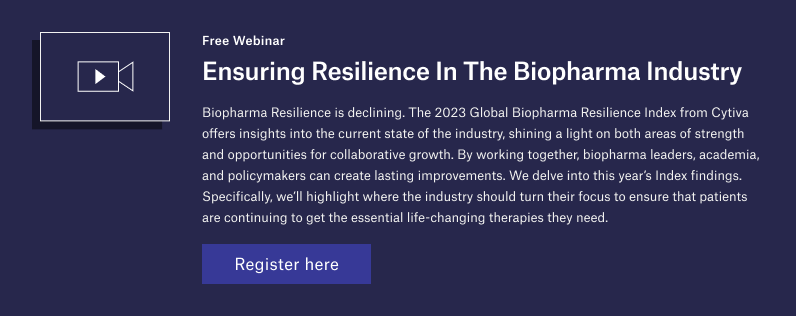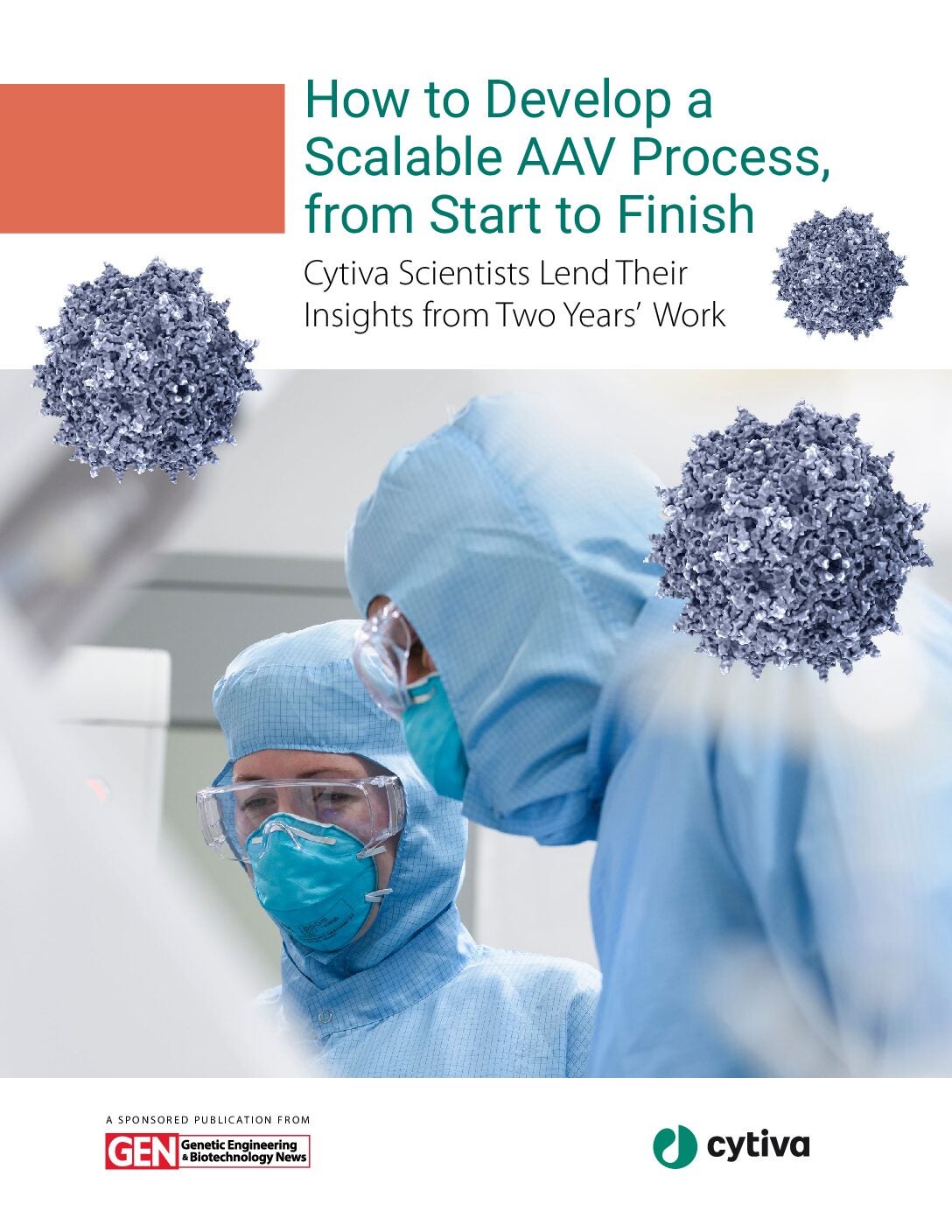
Viral vector manufacturing: the key to the success of gene therapy
Frost & Sullivan recently invited industry thought leaders working in the viral vector manufacturing space to participate in our Virtual Think Tank (VTT), a unique thought leadership platform that brings together leading minds, to discuss viral vector manufacturing facility design.
Participants included: Carol Houts, vice-president of quality and business strategy, Germfree; Peter Walters, advanced therapy medicinal product subject matter expert, CRB; Ryan McDonough, PE, senior vice-president of project operations, DPS; Steve Gravallese, program director, Cytiva; and Joseph Makowiecki, director of business development, Cytiva.
The focus of the most recent VTT was on the current challenges and trends influencing design considerations for viral vector manufacturing facilities and how they can impact companies developing cell and gene therapies.
According to the National Institutes of Health, “Gene Therapy is an experimental technique that uses genes to treat or prevent disease.” Gene therapy is a novel therapeutic area that may involve the insertion of a new gene or knock down an existing gene. Gene therapy can be of two types: in-vivo (gene transfer into cells happens inside a patient’s body) and ex-vivo (gene modification of cells happens outside a patient’s body and they are then transplanted into the patient). With over 2,200 clinical trials since 1989 and the advent of novel gene-editing tools and viral delivery vectors, gene therapy may hold the key to a possible cure by targeting the underlying causes of genetic diseases and rectifying them.
In recent years, we have witnessed a sharp increase in the number of gene therapies in pre-clinical and clinical studies, suggesting an exciting trend pointing to the possible emergence of treatments for medical conditions such as Hemophilia B, Spinal Muscular Atrophy, Muscular Dystrophy, thalassemia, etc. Even with the recent impact of the COVID-19 pandemic, viral vector-based COVID-19 vaccines are being actively pursued by a number of biopharmaceutical companies and academic institutions. So, the demand for viral vector manufacturing facilities that can cater to the needs of pre clinical, clinical and commercial development of gene therapies is only expected to increase exponentially year on year over the next decade.
Manufacturing challenges: possible growth inhibitors of gene therapy
Frost & Sullivan estimates the gene therapy market will reach $22.7 billion by 2024, growing at a 38.0% CAGR. The product portfolio of the gene therapy market is also set for a major expansion over the next five to ten years, which would require the bio-manufacturing industry to be well-equipped to meet the increased demands from the gene therapy market and enable biopharmaceuticals to successfully commercialize the products.
The first major challenge presented by these growing industries is the readiness for largescale manufacturing of viral vectors. Currently, there are around 15 viral-vector based vaccines in various stages of development targeting the COVID-19 virus. In addition, Frost & Sullivan estimates the potential launch of 20-25 gene therapy products over the next five years. With both in-vivo and ex-vivo (e.g., CAR-T) gene therapies predominantly leveraging viral vectors (lentivirus and AAV majorly) for the gene transfer mechanism, the global manufacturing bottleneck of viral vectors that currently exists can affect many companies worldwide and even slow down the distribution of any successful viral vector based vaccines.
Although biopharmaceutical contract development and manufacturing organizations (CDMOs) specializing in viral vector manufacturing can help, they are expected to be functioning at near capacity. Any resulting batch failures may compound the problem of increasing lead times for biopharmaceutical companies relying on the bio-CDMOs.
“A major factor for determining the best delivery method is determining how fast you need the facility and what degree of change will be needed to continue to make throughout design to match your evolving process,” says Peter Walters, Advanced Therapy Medicinal Product, Subject-Matter Expert-CRB.
Also, the inability to source critical materials rapidly is heavily impacting emerging gene therapy companies, both schedule-wise and financially. With a strong gene therapy pipeline, emerging biopharmaceuticals and innovative clinical-stage companies are having a hard time developing and clinically testing their therapies. Eventually, these companies will face a costly decision to raise funds and invest in a development and manufacturing facility for viral vectors or incur premium costs for collaborations with specialty bio-CDMOs for viral vector manufacturing.
The design optimization and standardization that have taken place for the manufacturing of monoclonal antibodies represent the gold standard that viral vector manufacturing needs to strive for. So, with optimization and standardization of manufacturing design and facility as the end goal, there are various evaluation criteria and industry trends that could play a key role in reaching the set goals. This paper outlines five impactful trends and criteria that will influence the future of viral vector manufacturing.
Obstacles to retro-fitting an existing facility
Another option for building a viral vector manufacturing facility is to retrofit an existing space environment or a completely re-purposed facility to be suitable for viral vector production. The design considerations for such a process may involve a number of challenges. Primary considerations that are critical to the process would be the design and condition of the existing shell building and utility infrastructure, followed by the conversion of the existing facility to accommodate the appropriate biosafety and room classification requirements.
Companies would need to assess the necessary structural and mechanical, electrical, and plumbing elements prior to lease or purchase. Infrastructure inadequacies may need to be addressed such as utility upgrades, similar to a box-inbox approach, independent from the main shell building. The design and age of the building would also need to be considered as these may result in upgrade inflexibilities. For instance, key industry experts point out that if a BSL- 1 monoclonal antibody manufacturing facility is to be retrofitted, the respective HVAC designs that are focused on particulate filtration, recirculation zones and cascade pressurization schemes need to be realigned to promote segregation and containment with design elements such as single-pass air, pressurization bubbles and sinks. They should also include additional air locks to separate vector manufacturing spaces from cleanroom circulation corridors as required by standard viral vector manufacturing facilities. In addition, the largescale operations may require HEPA filtration of the exhaust airflow at higher biosafety levels, which most companies design as bag-in bag-out in accordance with NIH requirements. Further, the design considerations for a viral vector manufacturing facility should also accommodate decontamination of cleanrooms, requiring, stainless HVAC ducting, bubble-tight dampers, dedicated air handling units (AHU) zones and single-pass air.
Three facility options for viral vector manufacturing
The foremost factors to consider for the design of a viral vector manufacturing facility are product pipeline and required capacities. These two factors will dictate the selection between a single product facility (either dedicated or operated on a campaign basis), which can encompass a more riskbased approach to design due to the negation of the possibility of cross-contamination with other products, and a multi-product concurrent manufacturing facility, which would require incorporation of significant design elements to support production segregation, carefully controlling things like material flows, personnel flows, waste flows, and airflows through the vector positive spaces.
To determine the best delivery method of a facility, companies need to assess the two driving factors: time and budget. As these factors have an inversely proportional relationship, companies must have a clear understanding and plan in terms of their requirements and designs to optimize the timelines and costs involved in building a facility.
Stick-built facility
Cost-effective but a long lead time: While stick-built facilities are typically the least expensive, they also take the longest to build. The major advantage of these facilities is that they are the most flexible design-wise and can accommodate late-stage design changes. Industry experts cite their personal experiences where project directive changes in stick-built facilities, such as changes to the room architecture to support new process demands, were accommodated during the mid-construction phase. They argue that stick-built models are probably the only delivery method that can support such changes since studs and drywall have essentially no lead time to produce. Other facility types cannot ideally accommodate such changes. On the downside, stick-built facilities require an enormous amount of time to be built in addition to the qualification process that would be required to be carried out on site.
Fully modular facility
Faster deployment model with a standardized design: The fully modular facility concept is expedited over a stick-built facility to facilitate faster delivery and potentially better quality. The advantages of a fully modular system are that the qualification, testing and documentation of equipment and facility can be accelerated before the facility reaches the factory site. Additional benefits include safer construction with work performed in a more controlled environment, less time and less contractors on the jobsite, less material waste due to a more controlled inventory, and a structurally stronger product in order to withstand the rigors of transportation and installation. The disadvantage of this type of facility is that the design may be limited to the capabilities of what the modular systems can provide. In turn, this would typically entail dimensional restraints for what can be delivered. Further, in this type of delivery method, companies would need to minimize design changes to ensure financial savings, and any significant design changes that are accommodated may result in a construction delay and an increase in associated costs.
Box-in-box model
Mobile facility model ready to deploy at site: The most recent advancement in facility-type offerings is the box-in-box approach. This model provides significant advantages for companies that want to adapt their manufacturing platform in the future without significant facility disruption. The model consists of a pre-fabricated facility that can be repurposed or moved to another location, depending on business needs, thus providing companies with a great degree of flexibility in moving manufacturing sites. Some of the thought leaders strongly expressed that the box-in-box model can optimize a facility footprint by taking advantage of vertical space, thus reducing an overall facility footprint. Importantly, this can result in financial benefits for companies as they provide a reduction in the price per square foot of the shell building. The major benefit with the box-in box model is an optimized schedule – “Speed Wins.”
Building around cGMP and safe biodisposal theme
To ensure that safety and quality are at the forefront of design considerations, the justification of design decisions should be heavily based on a robust risk assessment carried out at the manufacturing site under a quality risk management program. As the viral vector manufacturing designs are still in the early stages of development, experts point out that there is a lack of operational data for facility design optimization. This has resulted in the currently observed industry trend of adoption of conservative design features to mitigate unforeseeable risks in large-scale viral vector manufacturing facilities.
“Some of the major challenges with manufacturing viral vectors are the segregation and biosafety level requirements associated with the facilities,” says Ryan McDonough, Senior Associate, Biotechnology Core Team Leader-CRB.
Industry best practices: Industry experts unanimously agree that biosafety levels and containment require critical consideration. Containment zones should be identified based on the guidance from cGMP and biosafety in microbiological and biomedical laboratories (BMBL) 5th edition biosafety standards. In addition, biodecontamination processes and procedures consideration would be paramount, especially for managing multi-product facility changeovers. To ensure environmental safety, proper channels of waste streams and inactivation should be accounted for in the design.
Adoption of technological advances
The current industry trend is the increasing adoption of single-use technologies along with suspension-based cell cultures for viral vector manufacturing. Such technological advances need to be embraced by the industry to advance the viral vector manufacturing industry.
The adoption of suspension-based cell cultures will result in a more simplified and scalable process and one which can easily leverage existing single-use stirred tank bioreactors that have been utilized and optimized by the industry over the past 15 years.
“It’s easier and safer to use and then dispose single-use consumables than to try to clean and reuse equipment as you are exposing the operators and the environment to something that’s potentially infectious,” says Joseph Makowiecki, Director Business Development, Cytiva (formerly GE Healthcare Lifesciences).
The benefits of single-use technologies for traditional mAb production are well known in the industry. Adoption of single-use technologies throughout viral vector manufacturing will lead to speed to market, increased process flexibility and facility utilization as well as reduced overall costs.
Industry best practices: Industry experts agree that the closed and automated suspensionbased cell culture systems provide a plethora of advantages such as greater predictability, easier scalability platform to support both developmental and commercial manufacturing scale, and accelerated timeline for manufacturing and release of gene therapies.
Facility design standardization
Standardization is built upon decades of manufacturing best practices, facility optimization and a strong understanding of regulatory expectations. Embracing the concept of standardizing facility design and incorporation of good design practices will result in a faster design cycle, increase the probability of regulatory approval, create more consistent operations and, ultimately, provide better quality and service for the end users—the patients. For companies aiming to build multiple manufacturing sites, the process of facility design standardization will enable them to successfully meet the expectations of risk, quality and performance.
Industry best practices: The industry experts agree that the process of facility design standardization will enable companies to save both time and money while also not giving up flexibility or the ability to transform your manufacturing space as dictated by specific business needs in the future. Standardization should be a major consideration, especially for companies building manufacturing sites in multiple regions, as the facilities can then be replicated while also improved upon simultaneously to support smoother technology transfer, procedure development and staff training.
Final thoughts
In finalizing the design for viral vector manufacturing facilities, there are really only two major considerations for companies: time and cost. Companies will have to make smart decisions regarding the options they choose based on their project budget and the timeline by which companies initiate their product supply line. By establishing a clear idea and outline on the expected timeline and budget, companies can then choose the appropriate facility type or retrofit an existing facility of theirs, followed by adoption of the various critical design considerations, such as adoption of single-use technologies, building around required cGMP and biosafety standards, and the incorporation of standardization processes, which would help reduce costs and time to completion.
For more articles from Cytiva click HERE




